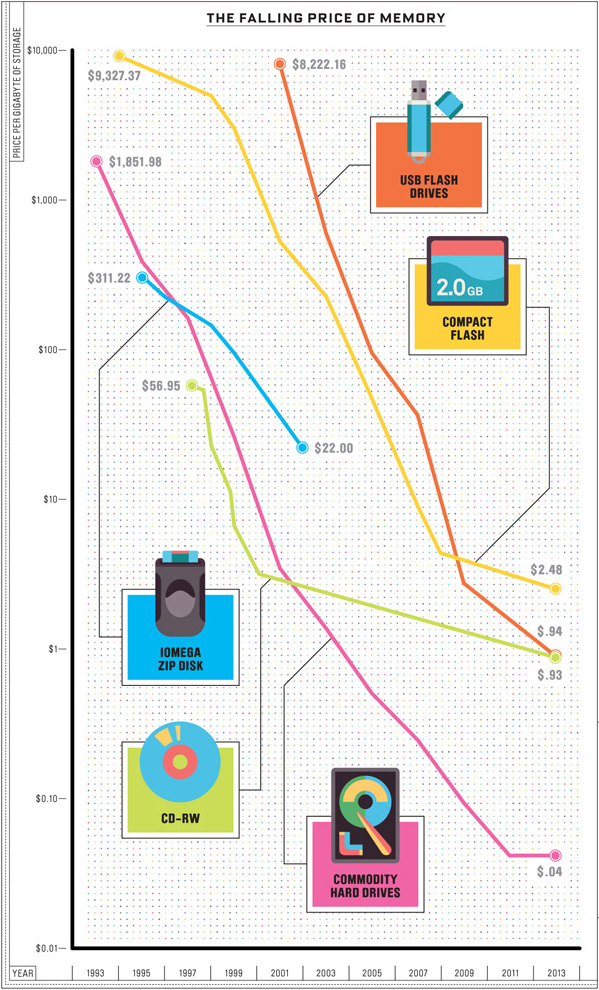
During the late ’90s, I met with Kodak in their HQ in Rochester, NY for a consulting project. I was impressed with the size of their campus. Our meeting was in building 84!
As I entered the front door, I remember feeling inspired by all the history and accomplishments of such a successful company. For over a century, Kodak was synonymous with quality photography. They pioneered the portable camera, empowering millions of shutterbugs around the world. And then the world of photography began to change.
The Kodak website used to include a timeline of accomplishments. Their milestones start with Eastman inventing a revolutionary way to capture photos using “dry film,” and it ends with Kodak filing for bankruptcy.
What happened in the middle is something we’ve seen time and again with companies like Blockbuster and Yellow Pages. It’s even common in other industries like the music and book publishing industries.
These companies failed to understand key technology trends, dismissing them as fads that would eventually go away. And unfortunately, they were never able to recover.
The three keys to meaningful innovation
Technology moves fast, really fast. And as Product Leaders, it’s our job to look towards the future to ensure our product won’t be obsolete the moment it launches. The following approaches to innovation will help you anticipate what’s coming and create amazing products that will continue to stay ahead of the curve.
1. Identify “hard trends.”
Daniel Burrus mentions in his book Flash Foresight: “The only way you can possibly get ahead of the curve is to solve tomorrow’s problems today.” The key is learning how to recognize “soft trends” and “hard trends,” so we can make smart decisions as we lead the direction of our products. Those trends are often in front of our noses and can help us see the seemingly invisible. Kodak, on the other hand, ignored the obvious trends and instead focused on solving today’s problems today. And by that time, it was too late.
2. Focus on your vision, not your product.
A few years ago, I worked on a project for one of the main media conglomerates in the US. Like many media companies, they had reduced revenues on their print offering, so they were looking for a bold play in the digital space. Their goal was to “go mobile” and make all their content accessible on tablet devices. During dinner, their CTO shared with me a very important remark: “Our vision is still valid, but our delivery method is obsolete.”
Vision drives great products, not the other way around. In other words, the company’s vision of providing timely news and entertainment to its subscribers (while making advertising revenue) was as valid today as when the company started decades ago. What was broken was the way they were delivering this information. Subscriptions to printed papers and magazines were in decline, and the operational costs were swallowing up the little profit they produced. Unfortunately, they were late to the digital game and were desperately trying to catch up before going bankrupt.
Similar examples come from Blockbuster and Yellow Pages. Blockbuster’s vision to provide home movie entertainment is still as valid as ever, but their delivery method became obsolete when Netflix took advantage of hard trends, like the constant increase of network bandwidth, to provide streaming media. Similarly, Yellow Pages’ vision to provide access to business and contact information is still valid today, but their delivery method became obsolete when Google gave us instant access to all that information and more through our browsers.
3. Balance today’s Sales with tomorrow’s investment.
It’s important to understand that some of the main challenges companies face in innovation are business-related, not technology related. In many companies, the Product team tends to be looking toward the future, while the Sales team tends to be looking at today. This narrow focus on the here and now is a common complaint among Product Managers.
Product challenges are usually business-related, not technology related. Companies are often Sales driven as opposed to Product / Market / User driven. As a result, many companies focus on solving the problems of today and dismiss the opportunity to invest in the products that will ensure continued success tomorrow. This is a very difficult pattern to break, but it’s an important one if we want our company to survive.
Later in this post, I’ll cover four things you can do to invest in and structure your innovation efforts.
Why Kodak Failed to Innovate
 In the case of Kodak, their vision was to empower everybody to capture their memories anytime and anywhere. Notice that their focus was not on technology, but on achieving a vision.
In the case of Kodak, their vision was to empower everybody to capture their memories anytime and anywhere. Notice that their focus was not on technology, but on achieving a vision.
Somewhere along the line, the products they created started to become more important than the vision itself. And since the company had been successful with those products, it’s easy to see how they thought they could be successful forever doing the same thing.
Those same blinders drove them to ignore the digital revolution and caused them to miss the bus on delivering their vision in a way that was consistent with technology trends and people’s expectations. They say hindsight is 20-20, but in reality, the trends were there, screaming at everybody, and they decided to ignore them. The hard trends I’m referring to are:
- Computers will continue to get more powerful every year
- The price of memory (storage in general) will continue to go down
- The internet will continue to grow, and everything will be connected
- The network bandwidth will continue to increase
- Smart, mobile devices will be ubiquitous
This chart (from Wired Magazine) shows the tremendous downward trend in the price of memory. When the first digital cameras came out, the storage capacity of memory cards was very small. It was common to keep several extra memory cards in your pocket just to take a handful of photos.
Many people saw this as a huge limitation and disregarded digital photography as a fad. But storage price is a hard trend. Memory cards are bound to continue increasing capacity and lowering the price. It’s no surprise that today we can store thousands of photos in a single card.
By ignoring this trend (among others), Kodak started on the road to obsolescence. Their vision (empowering users to capture photos) was still valid, but their delivery method (paper photos) was obsolete.
Imagine if Kodak had taken note of these trends and acted in a timely manner. Since they were the leaders in the space, they could have invested in a new path and could have outsmarted the competition before they even knew what hit them. Instead, they decided to pursue the status quo, and the rest is history.
Google’s Dedication to Vision
It’s important to align products with the company vision, even if the product seems to be strange at first. An interesting example is Google, whose vision is to “organize the world’s information and make it universally accessible and useful.”
When they started, their first product was a search engine. Given their huge success, it would have been comfortable to stay in that market and focus only on search. In that scenario, every new product and new release would revolve around making search better (and getting more ad revenue in the process).
Instead, they focused on the vision and branched out to create innovative offerings. It may sound strange to buy products like a mobile OS and apps (Android), a web browser (Chrome), a word processor (Google Docs) or digital storage (Google Drive) from a “search company.” And yet, we do it every day.
They are able to create (what seem to be) tangential products that support their vision. In many ways, it’s unfair to compare Google to Kodak since Google has only been around for 15 years. Only time will tell if they can continue to deliver on their vision 100 or more years from now.
Recommended reading: Demystifying the B2B Innovation Journey – A Map for Product Managers
Structuring your innovation efforts
As Product Leaders, it’s important to plan activities that look beyond today’s problems and prepare us for the future. Here are four key efforts that can help you stay ahead and create meaningful innovations.
Talk to analysts:
The job of an analyst is to keep up with trends in a particular industry. They can give you feedback on whether your product or roadmap is well aligned not only with the current trends but also with what’s coming several years out. If you can afford it, talk to analysts from multiple industries, not just your own. For example, talking with analysts from the mobile, cloud, and semiconductor industries can give you a good idea of where the main technology waves are headed and what to expect a few years down the road.
Lead an innovation lab:
Set aside some recurring times when you, your team, and anybody else interested can get together and brainstorm on how your product could be better. There shouldn’t be any limitations on the current way you do things, the state of technology, cost, etc. All ideas count. These ideas might become small projects to produce a proof of concept, and they might become your next product.
Give your employees time to innovate:
Companies like 3M or Google do this very well. Engineers get 20% of their time to work on anything they want. Granted, it takes support all the way up to approve the budget for these initiatives, but doing them shows a forward-thinking approach of not spending all employee time solving only today’s problems.
Innovate in non-product areas, too:
Most business people and technologists think of innovation in terms of only the product – new features and benefits, new visual design, new technology platforms, etc. But don’t forget that there’s a wider world of innovation opportunities that can earn new sources of revenue or cost reduction for your product or company as a whole.
This could mean an innovative pricing model, a new strategic partnership, a new sales channel, a unique approach to customer engagement, etc. In fact, innovation consultancy Doblin has identified ten different types of innovation, only two of which deal directly with the product.
According to Doblin’s research, product-only innovations are the least profitable and easiest for competitors to copy, while new offerings that integrate multiple kinds of innovation are the most successful and the hardest to copy.
Think of Apple’s technology ecosystem, which combines innovations in Product (iPhone, iPad, notebooks, etc.), networks (mobile service providers, app developers, media companies), structure (innovative working environment), profit model (app store, iTunes, etc.), channel (Apple-owned stores), service (Genius bar), branding (iWhatever), etc. Each offering they launch ties neatly into this ecosystem, and may push the limits in several areas of innovation.
The Bottom Line
The takeaway for Product Leaders is to keep an eye on the vision, pay attention to the trends, and champion meaningful investment in tomorrow. With some due diligence and a lot of luck, we might be able to keep pushing our products forward and away from obsolescence.
PS – For a blueprint on how to drive innovation for B2B products, check out my book: The B2B Innovator’s Map
5 Comments
good site thanks for sharing
An interesting complement to this article. Here’s the story of how Kodak and Apple launched the first digital camera 20 years ago.
http://mashable.com/2014/06/21/digital-camera-20th-anniversary/-Daniel
I like your reference to Doblin, and see his approach to innovation highlighting the challenges experienced by Kodak, Blockbuster and Yellow Pages in evolving their businesses, probably more than the organizations missing the “hard trends”.
I would suggest this was especially true for Kodak, a company that was deep in imaging and digital IP. I believe their real challenge was one of culture and business model, and the two were linked. There was literally so much cultural momentum and business infrastructure around products with amazingly high gross margins that it completely blurred the inevitable.
There was massive technology innovation that enabled the movement to digital photography, but every box on Doblin’s chart was checked to deliver on the promise of a re-invented industry.
A lot of wisdom here. I really enjoyed Burris’ book as well.
Focusing on your vision and your goals is something a lot of folks don’t take the time to do. It’s very easy to get caught up in endless lists of customer requests and incremental improvements and forget about the big picture and what business they are really in.
The newspaper story is apt. For a long time, it seemed most papers forgot they were in the information business, thinking they were in the print business and that the website was just a way to promote the “main product.” It took too long to change direction and those businesses have lost millions of customers and dollars. I am very curious to see how Jeff Bezos’ investment in the Washington Post plays out.
Readers may also be interested in this article about looking at all of your product priorities through the lens of your organization’s strategic goals: http://www.productpowers.com/blog/product-priorities-start-with-strategic-goals.html
Bruce,
I agree that prioritization needs to be strategic and aligned with the company goals. Otherwise, we are not really pushing the product and the business forward. Thanks for sharing that link.



